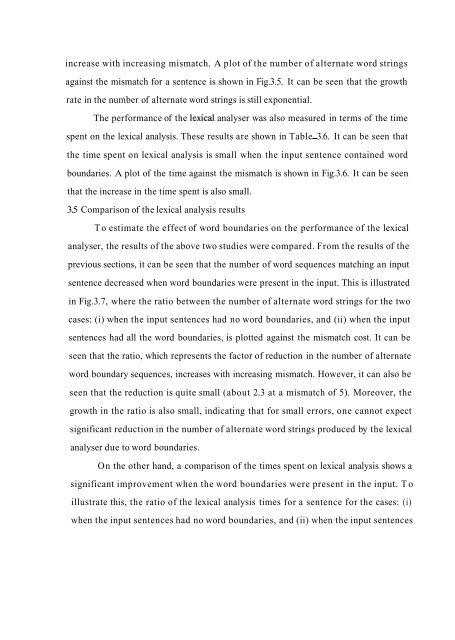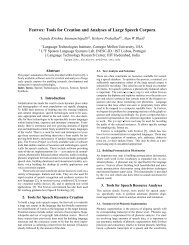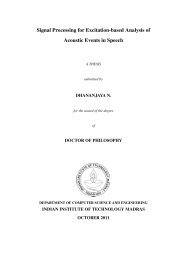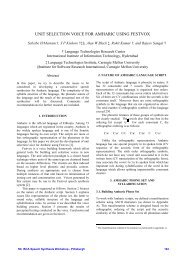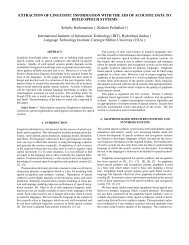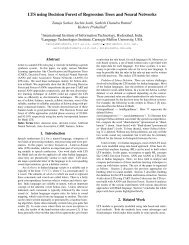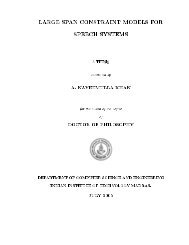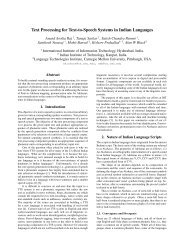word boundary- hypothesisation in hindi speech - Speech and ...
word boundary- hypothesisation in hindi speech - Speech and ...
word boundary- hypothesisation in hindi speech - Speech and ...
Create successful ePaper yourself
Turn your PDF publications into a flip-book with our unique Google optimized e-Paper software.
<strong>in</strong>crease with <strong>in</strong>creas<strong>in</strong>g mismatch. A plot of the number of alternate <strong>word</strong> str<strong>in</strong>gs<br />
aga<strong>in</strong>st the mismatch for a sentence is shown <strong>in</strong> Fig.3.5. It can be seen that the growth<br />
rate <strong>in</strong> the number of alternate <strong>word</strong> str<strong>in</strong>gs is still exponential.<br />
The performance of the lexical analyser was also measured <strong>in</strong> terms of the time<br />
spent on the lexical analysis. These results are shown <strong>in</strong> Table - 3.6. It can be seen that<br />
the time spent on lexical analysis is small when the <strong>in</strong>put sentence conta<strong>in</strong>ed <strong>word</strong><br />
boundaries. A plot of the time aga<strong>in</strong>st the mismatch is shown <strong>in</strong> Fig.3.6. It can be seen<br />
that the <strong>in</strong>crease <strong>in</strong> the time spent is also small.<br />
3.5 Comparison of the lexical analysis results<br />
To estimate the effect of <strong>word</strong> boundaries on the performance of the lexical<br />
analyser, the results of the above two studies were compared. From the results of the<br />
previous sections, it can be seen that the number of <strong>word</strong> sequences match<strong>in</strong>g an <strong>in</strong>put<br />
sentence decreased when <strong>word</strong> boundaries were present <strong>in</strong> the <strong>in</strong>put. This is illustrated<br />
<strong>in</strong> Fig.3.7, where the ratio between the number of alternate <strong>word</strong> str<strong>in</strong>gs for the two<br />
cases: (i) when the <strong>in</strong>put sentences had no <strong>word</strong> boundaries, <strong>and</strong> (ii) when the <strong>in</strong>put<br />
sentences had all the <strong>word</strong> boundaries, is plotted aga<strong>in</strong>st the mismatch cost. It can be<br />
seen that the ratio, which represents the factor of reduction <strong>in</strong> the number of alternate<br />
<strong>word</strong> <strong>boundary</strong> sequences, <strong>in</strong>creases with <strong>in</strong>creas<strong>in</strong>g mismatch. However, it can also be<br />
seen that the reduction is quite small (about 2.3 at a mismatch of 5). Moreover, the<br />
growth <strong>in</strong> the ratio is also small, <strong>in</strong>dicat<strong>in</strong>g that for small errors, one cannot expect<br />
significant reduction <strong>in</strong> the number of alternate <strong>word</strong> str<strong>in</strong>gs produced by the lexical<br />
analyser due to <strong>word</strong> boundaries.<br />
On the other h<strong>and</strong>, a comparison of the times spent on lexical analysis shows a<br />
significant improvement when the <strong>word</strong> boundaries were present <strong>in</strong> the <strong>in</strong>put. To<br />
illustrate this, the ratio of the lexical analysis times for a sentence for the cases: (i)<br />
when the <strong>in</strong>put sentences had no <strong>word</strong> boundaries, <strong>and</strong> (ii) when the <strong>in</strong>put sentences


